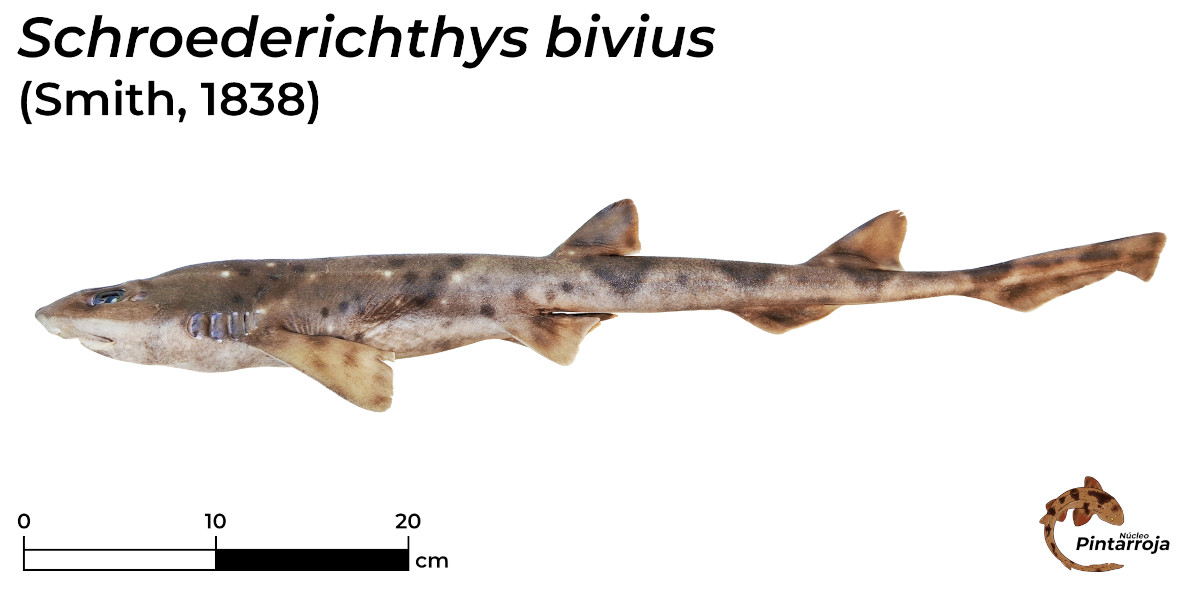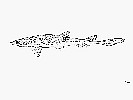Schroederichthys bivius
(Smith in Müller & Henle, 1838)
Narrowmouthed catshark
Classification: Elasmobranchii Carcharhiniformes Scyliorhinidae
Reference of the original description
Systematische Beschreibung der Plagiostomen. Berlin, Veit, pp. 1–200
Systematische Beschreibung der Plagiostomen. Berlin, Veit, pp. 1–200
Image of the original description
No image in first description.
No image in first description.
Synonyms / new combinations and misspellings
Halaelurus bivius, Scyliorhinus bivius, Scyliorhinus (Halaelurus) bivius, Scylliorhinus bivius, Scyllium bivium
Halaelurus bivius, Scyliorhinus bivius, Scyliorhinus (Halaelurus) bivius, Scylliorhinus bivius, Scyllium bivium
Description :
Citation: Schroederichthys bivius (Smith in Müller & Henle, 1838): In: Database of modern sharks, rays and chimaeras, www.shark-references.com, World Wide Web electronic publication, Version 11/2025
Please send your images of "Schroederichthys bivius" to info@shark-references.com

Schroederichthys bivius (Müller & Henle, 1838), male, 586 mm TL, off Calbuco, southern Chile © L. Ignacio Contreras

Schroederichthys bivius (Müller & Henle, 1838), male, 586 mm TL, off Calbuco, southern Chile © L. Ignacio Contreras
Common names
 Pejegato bocachica,
Pejegato bocachica,  Pintarroja,
Pintarroja,  Holbiche blanche,
Holbiche blanche,  Narrowmouth cat shark,
Narrowmouth cat shark,  Narrowmouth catshark,
Narrowmouth catshark,  Narrowmouthed catshark,
Narrowmouthed catshark,  Tubarão-lagarto
Tubarão-lagarto
 Pejegato bocachica,
Pejegato bocachica,  Pintarroja,
Pintarroja,  Holbiche blanche,
Holbiche blanche,  Narrowmouth cat shark,
Narrowmouth cat shark,  Narrowmouth catshark,
Narrowmouth catshark,  Narrowmouthed catshark,
Narrowmouthed catshark,  Tubarão-lagarto
Tubarão-lagarto
Short Description
Diagnosis after Compagno, 1984 [517]: Field Marks: A Schroederichthys with moderately slim body, narrow snout, and few large dark and small white spots. Diagnostic Features : Trunk and tail fairly slender in adults but extremely attenuated in young. Snout narrowly rounded; anterior nasal flaps narrow and lobate. Mouth relatively narrow and long, especially in adult males. Colour pattern of 7 or 8 dark brown saddles on grey-brown dorsal surface, also relatively few, scattered large dark and small white spots, the dark spots not bordering the saddles. Adults to at least 70 cm.
Diagnosis after Compagno, 1984 [517]: Field Marks: A Schroederichthys with moderately slim body, narrow snout, and few large dark and small white spots. Diagnostic Features : Trunk and tail fairly slender in adults but extremely attenuated in young. Snout narrowly rounded; anterior nasal flaps narrow and lobate. Mouth relatively narrow and long, especially in adult males. Colour pattern of 7 or 8 dark brown saddles on grey-brown dorsal surface, also relatively few, scattered large dark and small white spots, the dark spots not bordering the saddles. Adults to at least 70 cm.
Distribution
Southeast Pacific and Southwest Atlantic: central Chile to the Straits of Magellan and Argentina. Source: www.gbif.org
Southeast Pacific and Southwest Atlantic: central Chile to the Straits of Magellan and Argentina. Source: www.gbif.org
Human uses
fisheries: of no interest
fisheries: of no interest
Biology
Oviparous, paired eggs are laid. Embryos feed solely on yolk [733]. Sexual dimorphism is evident in dentition of male species (Ref. 49562). Males have longer teeth with fewer cusps than females (Ref. 51093) to make "quot;courtship biting"quot; more effective (Ref. 49562). Feeds on invertebrates and fish (Ref. 43115).
Oviparous, paired eggs are laid. Embryos feed solely on yolk [733]. Sexual dimorphism is evident in dentition of male species (Ref. 49562). Males have longer teeth with fewer cusps than females (Ref. 51093) to make "quot;courtship biting"quot; more effective (Ref. 49562). Feeds on invertebrates and fish (Ref. 43115).
Remarks
shark-references Species-ID=6227;
shark-references Species-ID=6227;
Parasites (arranged by Jürgen Pollerspöck)
Copepoda
Copepoda
- Lernaeopoda bivia Leigh-Sharpe, 1930 [32531]
- Tautochondria magellanica Munoz, Hernandez & Lopez, 2023 [31453]


















